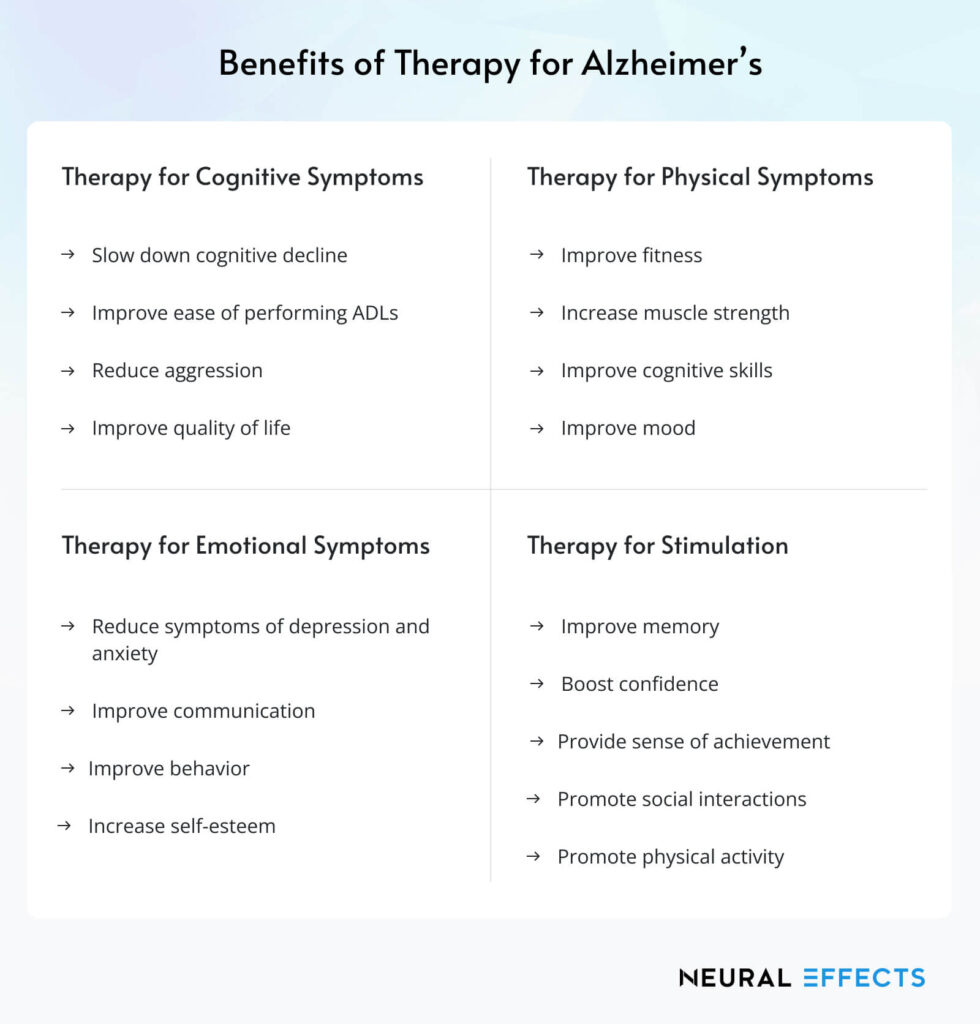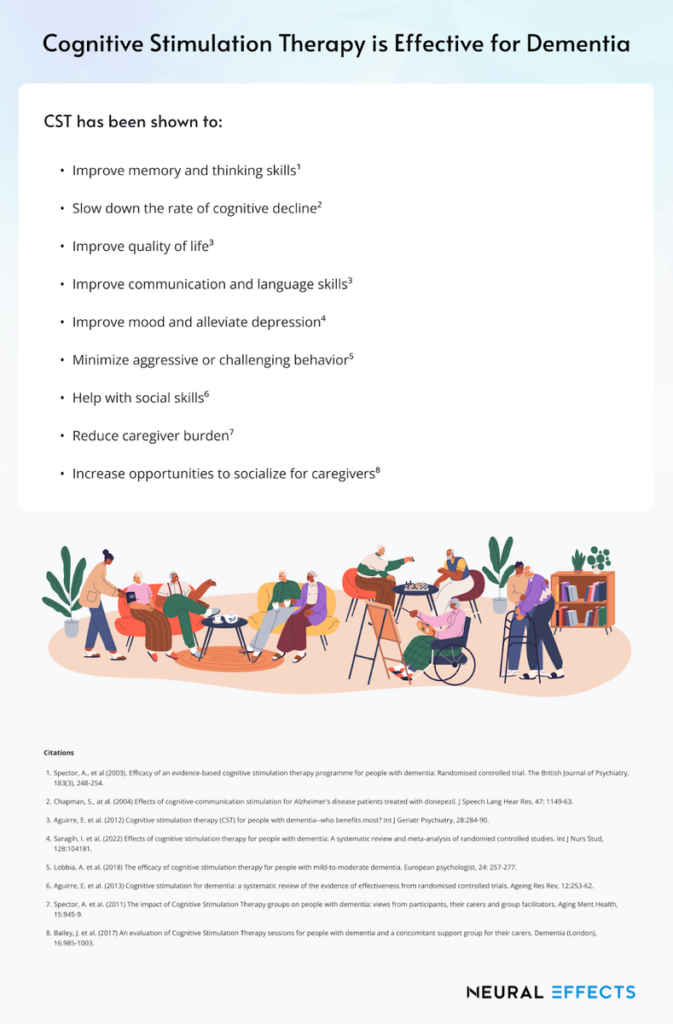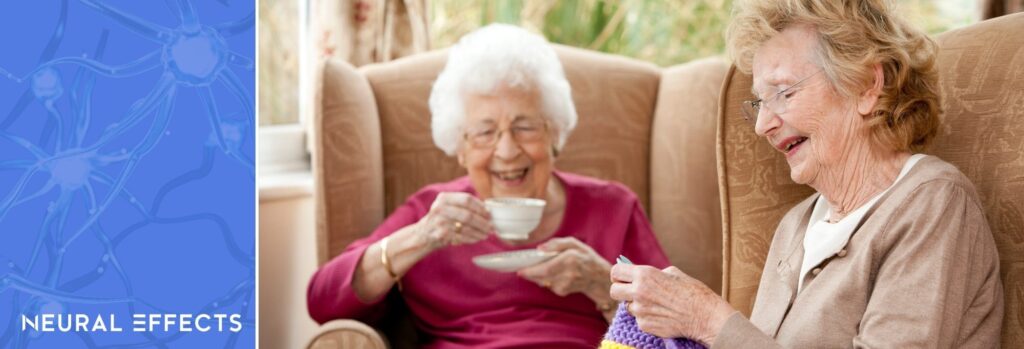Due to its complexity, Alzheimer’s disease requires a multifaceted treatment approach involving lifestyle changes and multiple therapies to address its effects.
But a multipronged treatment approach is not always easy for patients to find. Many doctors offer only one approach and may not offer therapies besides medication. For many patients, comprehensive treatment means going to many treatment providers, which can be time-consuming and frustrating, especially if those providers aren’t communicating with each other.
But some clinics do offer a more holistic approach. At our clinic, Neural Effects (located in Provo, Utah), we offer a combination of cognitive stimulation therapy and physical exercise to protect brain function, improve fitness, and promote social interactions — all under one roof. We also educate family and caregivers and make recommendations for needed lifestyle changes. Finally, for patients who are taking medication for dementia or receiving some other form of treatment, we always keep in touch with their providers so that everyone is in agreement on how to move forward with treatment.
It’s worth it to find a provider or set of providers who can offer a multifaceted approach to treatment.
In this article, we’ll explain:
- What the research-backed benefits of therapy for Alzheimer’s are (organized by therapy type)
- What the benefits of healthy lifestyle choices are for Alzheimer’s patients
- What therapy for Alzheimer’s disease looks like at Neural Effects
- What you need to know about pharmacological therapies for Alzheimer’s disease
Neural Effects uses the latest evidence-based techniques to diagnose and help dementia patients. We are located in Provo, Utah and serve anyone in Salt Lake City or the Utah Valley area. We are in network for most types of medical insurance. Schedule your evaluation today.
Benefits of Therapy for Patients with Alzheimer’s Dementia

There are many different therapies available for patients with Alzheimer’s disease. For the purpose of this article, we are going to group them into four categories:
- Therapies to deal with cognitive symptoms
- Therapies to deal with physical symptoms
- Therapies to deal with emotional symptoms
- Therapies to stimulate patients
In this article, we want to look at the benefits that each therapy group can offer patients. If you want to know more about what specific therapies entail, we’ve covered them in more detail in other articles, including 24 interventions to treat dementia and how to help dementia patients.
While these therapies cannot remove tau protein tangles, they can slow down the cognitive decline patients experience and reduce symptom burden.
Benefits of Therapies for Cognitive Symptoms
Memory loss and other cognitive impairments are the most common symptoms in patients with Alzheimer’s disease. Inevitably, as a consequence of these symptoms, patients start to struggle with activities of daily living (ADLs), such as completing household chores, shopping, or managing finances. These difficulties affect the patients’ quality of life and eventually prevent them from living independently. As such, interventions to slow down dementia-related cognitive decline and bolster patients’ abilities to engage in daily life are key.
For patients in the early stages of the disease, the best option includes some form of cognitive therapy, such as cognitive rehabilitation or cognitive stimulation therapy (which we use at Neural Effects and will describe later).
Patients with severe Alzheimer’s disease and other dementias may not be able to participate in these treatments but can still benefit from less challenging therapies like validation or reality orientation therapy, in which patients are encouraged to remember simple information like the date and time of day. The benefits may not be as evident as during early Alzheimer’s disease, but patients still experience small improvements in cognition, function, behavior, and social interaction.
Not surprisingly, the main benefit from cognitive therapies is a slower loss of cognitive function in patients who attend therapy compared to those who don’t. “Exercising” the brain with activities that target cognitive skills (such as memory, attention, and problem solving) promotes a process called neuroplasticity.
In simple terms, therapy helps the brain develop new neural pathways and strengthens existing ones, thereby mitigating symptoms associated with dementia, such as memory loss and disorientation.

The good news is that studies show that while older adults may lose some cognitive functionality with age, their brains actually never lose the ability to change in response to therapy. The bad news is that any gains in a particular cognitive function are not easily “transferred” to another. This means that exercises to improve memory, for example, often don’t help with problem-solving skills. This makes it all the more important that the therapy regimen addresses more than just one symptom or skill set.
Therapy also helps patients cope better with everyday activities and maintain their independence. For example, patients may need help practicing how to use a mobile phone or developing strategies to safely withdraw money from an ATM. In turn, this type of therapy reduces signs of aggression and other behavioral symptoms, improves patients’ quality of life, and promotes social participation.
Further reading: Where to find cognitive stimulation therapy near me
Benefits of Therapies for Physical Symptoms
As dementia progresses, patients also experience physical complications, such as stiff and/or weak muscles, fatigue, and loss of balance or coordination that can lead to falls. In this case, physical therapy (also called physiotherapy) and occupational therapy are ideal tools to help these patients. Physical therapy works to strengthen the body and help it adapt to changes during dementia. And occupational therapy works to reduce risk factors for falls, helps the patient develop coping mechanisms against cognitive decline, and more.
Crucially, as the disease progresses, therapists can adapt the exercises to accommodate the patient’s changing needs. In the early and middle stages of Alzheimer’s disease, therapists help patients stay active and continue to perform their roles at home and in the community. As the disease progresses, however, patients experience more severe physical issues and become less mobile. At this stage, therapists can still help with exercises to support tasks like getting in and out of bed and chairs to allow patients some mobility during the day.
Keeping patients active with age- and ability-appropriate exercises to improve balance, stability, and coordination can help relieve stiff muscles, improve muscle strength, and increase fitness. In turn, patients can move more comfortably, are less likely to fall and injure themselves, and can enjoy their daily activities.
Physical activity also helps cognitive skills. Exercise promotes blood flow to the brain and induces long-term changes in an area of the brain called the hippocampus, which is crucial to forming memories and memory retrieval. For example, one study found that loss of cognitive function is twice as common in patients who are inactive compared to those who are active.
Physical activity also relieves stress and improves mood by reducing the levels of the stress hormone cortisol and promoting the release of “feel-good” chemicals called endorphins in the brain. Exercise improves the patients’ self-esteem and makes them more willing to socialize and try new experiences.
Further reading:
- Physical therapy for dementia
- 25+ exercises from physical therapy for dementia patients
- Occupational therapy for dementia
Benefits of Therapies for Emotional Symptoms

Patients with dementia often struggle with feelings of grief, loss, anger, shock, and fear. They may feel afraid about the future, frightened about what they are going to forget, and worried about the impact their dementia has on loved ones. It’s not uncommon for these patients to develop anxiety, depression, and other mental health problems.
Talk therapies, such as counseling and cognitive behavioral therapy (CBT), can be helpful for patients during the early stages of the disease when patients are still capable of talking with a psychologist. There are also other therapies which are more suitable for patients in the later stages of the disease when communication problems are more pronounced, including validation therapy, sensitive listening, or sensory stimulation.
The main benefit of these therapies is to help with symptoms of anxiety and depression. For example, talking therapies give patients a chance to speak openly about their emotions, including how they feel about their diagnosis. It also provides patients with coping strategies to manage negative emotions and teaches them how to communicate more effectively with carers and loved ones. As a result, patients learn to deal with behavioral problems, including aggression, repetitive behavior, and aimless walking, which increases their sense of control and self-esteem.
Benefits of Therapies That Stimulate Patients’ Minds and Senses
In contrast to the above options, therapies to stimulate patients don’t focus on a specific problem. Instead, these therapies provide general recreational activities, such as doing arts, listening to music, or playing with pets, allowing patients to engage in pleasurable activities while also encouraging social interactions.
There are many different therapies that fall within this category, but overall, the main benefits are stimulating the patients’ minds and helping them engage in other activities more easily. Various dementia and Alzheimer’s disease research studies have shown that patients can experience improvements in cognitive skills through art and music therapy, for example.
Asking patients to paint something, to listen to certain music, or to play with a pet can also help jog memories from their past. This not only brings them a sense of joy and happiness, but it also helps them reminisce and improves their memory. This can boost their confidence and give them a sense of achievement and purpose.
In addition, activities such as dancing or taking a dog for a walk require a certain amount of physical movement and strength. Many of these therapies allow patients to combine physical and cognitive components to slow the progression of the disease.
Finally, many of these activities are done in a group, promoting social interactions, decreasing feelings of isolation, and generally improving mental health.
| Benefits of Therapy for Alzheimer’s | |
|---|---|
| Therapy for Cognitive Symptoms ○ Slow down cognitive decline ○ Improve ease of performing ADLs ○ Reduce aggression ○ Improve quality of life |
Therapy for Physical Symptoms ○ Improve fitness ○ Increase muscle strength ○ Improve cognitive skills ○ Improve mood |
| Therapy for Emotional Symptoms ○ Reduce symptoms of depression and anxiety ○ Improve communication ○ Improve behavior ○ Increase self-esteem |
Therapy for Stimulation ○ Improve memory ○ Boost confidence ○ Provide sense of achievement ○ Promote social interactions ○ Promote physical activity |
Benefits of Adopting Positive Lifestyle Choices

Adopting a combination of healthy lifestyle choices, such as eating well, regularly exercising, challenging the brain, and socializing helps slow the rate of memory decline and allows patients to live independently for longer.
An active lifestyle also helps preserve the patients’ sense of identity, reduces stress, boosts self-esteem, improves sleep quality, and reduces symptoms of anxiety and depression. In addition, strong relationships with loved ones can help patients cope with their condition, reduce the stigma associated with Alzheimer’s, and improve quality of life.
This is just a general overview regarding the benefits of choosing a healthy and active lifestyle. We’ve written in more detail elsewhere about ways to treat dementia at home, including which supplements have been shown to reduce symptoms of Alzheimer’s dementia.
Combined Cognitive Therapy and Exercise at Neural Effects

At Neural Effects, we offer a combination of cognitive stimulation therapy (CST) and physical exercise to help delay progression of symptoms. We call this the EMPOWER program, a new treatment approach that allows patients to reap the benefits from multiple types of therapy.
At our clinic, patients attend 14 sessions (twice a week for seven weeks). Sessions start with 10-15 minutes of aerobic exercise, usually done on a treadmill or stationary bike. Our therapists understand that some of our patients have limited mobility and can adapt exercises for safety.
Exercise is a crucial part of the treatment of Alzheimer’s disease, as it triggers the release of a specialized protein in the brain called brain-derived neurotrophic factor (BDNF). In turn, BDNF encourages the formation and storage of memories, enhances learning, and boosts cognitive performance. These sessions also provide all other benefits described earlier, including decreased risk of falls and increased fitness.
After exercise, patients attend a CST session, which includes activities to stimulate cognitive skills, such as word games, puzzles, creative activities, and practical activities. Two trained facilitators work with a small group of six patients to help them stay engaged and focused. This also gives patients an opportunity to interact socially with other patients in similar circumstances.
At the end of the treatment, if our team believes patients may benefit from additional therapy, we can refer them to the right healthcare providers, such as ENTs, neurologists, occupational therapists, or psychologists. Our treatment program is appropriate for those with mild cognitive impairment, early dementia, or mild to moderate Alzheimer’s dementia and related dementias.
At Neural Effects, we also support the families of patients with Alzheimer’s. Family members can attend the first session to learn about CST and repeat the exercises at home. We also share resources with loved ones about how to care for a relative with dementia and suggest lifestyle changes that can help slow down progression of symptoms. If you are looking for local or online support groups, we can also help with recommendations.
We are in network for most types of medical insurance. Schedule your evaluation today.
Patients Should Carefully Consider Medication

In this article, we’ve focused mainly on non-pharmacological options, but patients with Alzheimers’ disease can also choose from multiple pharmacological treatments.
The list of drugs currently approved by the U.S. Food and Drug Administration (FDA) to treat Alzheimers’ disease includes:
- Galantamine (Razadyne), rivastigmine (Exelon), and donepezil (Aricept) as cholinesterase inhibitors
- Memantine (Namenda) as a glutamate antagonist
- Lecanemab (Leqembi) and aducanumab (Aduhelm) as a way to potentially dissolve beta-amyloid plaques
- Drugs to treat specific symptoms, such as antidepressants, sleep aids, or antipsychotic drugs
Note that aducanumab received controversial, accelerated approval from the FDA, and many health organizations refuse to prescribe it due to the dangerous side effects — a nuance that the Alzheimer’s Association fails to address in their educational material on aducanumab and lecanemab.)
These drugs can help some patients, but usually the benefits are limited and short-lived. In addition, all of these medicines have multiple side effects identified in clinical trials, such as nausea, vomiting, diarrhea, constipation, allergic reactions, loss of appetite, headaches, confusion, dizziness, and falls, to name just a few. FDA approval does not mean that the drug is extremely effective or that it does not have dangerous side effects.
At the moment, our recommendation is not to rely exclusively on medication to treat dementia symptoms. Patients usually experience better results with either non-pharmacological treatments alone or a combination of both drug and non-drug treatment options.
Neural Effects uses the latest evidence-based techniques to diagnose and help dementia patients. We are located in Provo, Utah and serve anyone in Salt Lake City or the Utah Valley area. We are in network for most types of medical insurance. Schedule your evaluation today.
